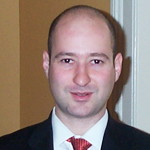As the majority of financial instruments are now traded electronically and in a fragmented fashion, there are a number of reasons to engage into algo and high-frequency trading.
The regulatory regime is demanding transparency and recording, the spreads are tightening, the cost of technology is decreasing, the exchanges and other market places are becoming more technologically advanced, trade formats are becoming industry-accepted standards, market volatility is a new norm, temporary mispricing is a common occurrence in the global markets, and the number of electronic venues is growing every year.
In my presentation, I am going to show examples of several algorithmic trading and high-frequency trading strategies (both from a business and technology perspectives), including Pairs Arbitrage, Statistical Arbitrage, Index Arbitrage, ADR Arbitrage, Program Trading, Event-driven Strategies, DMA, TCA, Market Making and Dark Pool–based Strategies.
I am going to present several new technologies, such as FPGA and GPU and provide examples how they can help in low-latency trading. Finally, I will touch upon the topic of co-location and how such approach can also help with latency reduction, the main goal behind high-frequency trading.
Author: Eric Karpman
Independent consultant and a subject-matter expert in the financial technology space
Eric Karpman is a well-known subject matter expert in financial and trading technology and have worked or consulted for a number of global investment banks and asset managers in finding and implementing strategies to maximize return. Karpman has over 19 years of financial experience. During his tenure on Wall Street, he worked on the equity trading sell-side at Deutsche Bank, Renaissance Capital, Fuji Bank/Mizuho and Bloomberg, on the fixed income trading sell-side at JJKennyDrake trading unit of Standard & Poor’s, on various trading desks at Bear Stearns as well as for the buy-side at BNY Mellon Asset Management. Throughout his career, Eric and his teams have successfully implemented electronic trading systems with direct interfaces to the Street as well as the algorithmic, program and direct market access trading platforms for instant market analysis, decision-making capabilities and straight-through processing. In 2004, Eric was elected a Co-Chair of the FIX Protocol Technical Committee where he was involved with the future direction and the strategy of this messaging standard developed specifically for the real-time electronic exchange of securities transactions. In addition, Eric has written a number of books and articles describing multi-asset class trading systems he has built that cover equities, fixed income, derivatives and FX products for successful trading strategies’ implementation. Eric is a graduate of the M.B.A. program in Finance at the New York University Stern School of Business. He is also a holder of NASD Series 7, 55 and 63 Licenses.

 Русский
Русский  English
English 






























